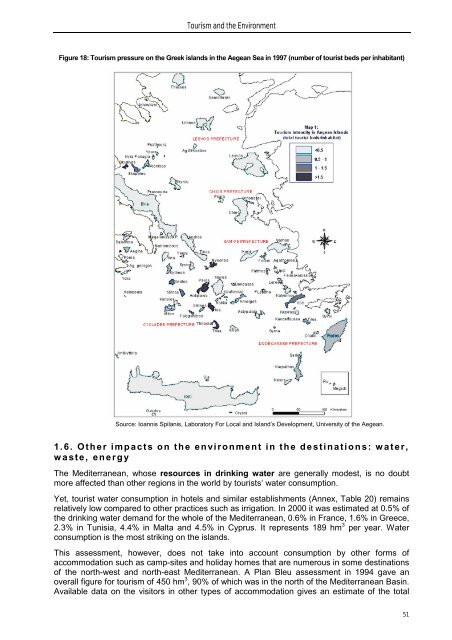dossier sur le tourisme et le développement durable
dossier sur le tourisme et le développement durable
dossier sur le tourisme et le développement durable
Create successful ePaper yourself
Turn your PDF publications into a flip-book with our unique Google optimized e-Paper software.
Tourism and the Environment<br />
Figure 18: Tourism pres<strong>sur</strong>e on the Greek islands in the Aegean Sea in 1997 (number of tourist beds per inhabitant)<br />
Source: Ioannis Spilanis, Laboratory For Local and Island’s Development, University of the Aegean.<br />
1.6. Other impacts on the environment in the destinations: water,<br />
waste, energy<br />
The Mediterranean, whose resources in drinking water are generally modest, is no doubt<br />
more affected than other regions in the world by tourists’ water consumption.<br />
Y<strong>et</strong>, tourist water consumption in hotels and similar establishments (Annex, Tab<strong>le</strong> 20) remains<br />
relatively low compared to other practices such as irrigation. In 2000 it was estimated at 0.5% of<br />
the drinking water demand for the who<strong>le</strong> of the Mediterranean, 0.6% in France, 1.6% in Greece,<br />
2.3% in Tunisia, 4.4% in Malta and 4.5% in Cyprus. It represents 189 hm 3 per year. Water<br />
consumption is the most striking on the islands.<br />
This assessment, however, does not take into account consumption by other forms of<br />
accommodation such as camp-sites and holiday homes that are numerous in some destinations<br />
of the north-west and north-east Mediterranean. A Plan B<strong>le</strong>u assessment in 1994 gave an<br />
overall figure for tourism of 450 hm 3 , 90% of which was in the north of the Mediterranean Basin.<br />
Availab<strong>le</strong> data on the visitors in other types of accommodation gives an estimate of the total<br />
51
















